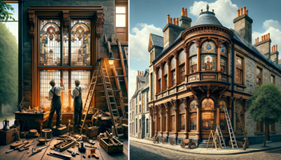Historical Window Restoration
Welcome to Historical Window Restoration, where we step back in time to explore the fascinating art of preserving and reviving the windows that have witnessed history. This comprehensive guide takes you through the intricate process of restoring these architectural jewels, highlighting their historical significance and the meticulous craftsmanship required to bring them back to their former glory. We delve into the evolution of window designs, the challenges faced in restoration, and the harmonious blend of age-old techniques with contemporary practices. Join us on this enlightening journey as we uncover the stories etched in glass and wood and celebrate the skilled artisans dedicated to keeping the windows to our past open and resplendent.

The Evolution of Window Design
The Journey through Time
Travelling back in time, windows have evolved from simple openings to complex, artistic statements. In the mediaeval era, windows were often small with iron or wooden frames, gradually giving way to larger, more elaborate designs in the Renaissance. The Victorian and Georgian eras brought in sash and bay windows, adding character to buildings. Each period left its own unique mark on window design, contributing to the rich tapestry of architectural history.
Architectural and Cultural Significance
Historical windows are more than just a part of the building’s structure; they’re a glimpse into the past. From the leaded glass windows of Tudor times to the ornate stained glass of Gothic churches, each style reflects the cultural and technological advancements of its era. They tell stories of craftsmanship, design trends, and the societal values of the time.
Icons of the Past
Consider the grandeur of the Palace of Versailles or the Gothic beauty of Notre Dame. Their windows are not just openings; they are integral to their architectural identity. Such iconic buildings remind us of the importance of preserving these historical treasures.
Assessing the Condition of Historical Windows
Identifying Common Issues
Restoration begins with a careful assessment. Historical windows often face issues like wood rot, weathering, and damage from environmental factors. Lead paint, common in older windows, poses health risks and requires careful handling. Identifying these issues early is crucial for a successful restoration.
Structural Integrity Evaluation
Assessing a window’s structural integrity involves examining the frame, glass, and supporting structures. Techniques like ultrasonic testing can be used to gauge the condition of the wood without causing any damage. This evaluation helps determine whether a window can be restored or needs to be replaced.
The Restoration Decision
Deciding whether to restore, repair, or replace is a critical step. While restoration maintains historical accuracy, sometimes replacement with a replica is necessary for safety or efficiency. This decision hinges on the window’s condition, historical value, and the building’s requirements.
Techniques and Materials in Window Restoration
Traditional Restoration Methods
The art of restoring historical windows is steeped in tradition. Skilled artisans often employ time-honoured techniques such as handcrafting individual window panes and using linseed-oil-based putty, which has been a staple in window repairs for centuries. These methods require not just skill but also patience, as they often involve intricate, manual work that can’t be rushed.
Modern Innovations
While tradition forms the backbone of restoration, modern advancements have their place too. Techniques like thermal imaging can detect air leaks and insulation issues in historical windows, guiding restorers to enhance energy efficiency while preserving historical integrity. Additionally, modern materials like epoxy resins can be used to repair wooden frames without compromising their historical appearance.
Case Studies: A Blend of Old and New
Successful restoration projects often blend traditional and modern methods. For instance, a project might involve restoring the original glass while reinforcing the frame with modern materials. Case studies from renowned restoration projects can provide valuable insights into this intricate process.
Navigating Challenges in Restoration
Balancing Authenticity and Practicality
One of the biggest challenges in historical window restoration is striking a balance between authenticity and modern building codes. Restorers must navigate how to maintain historical accuracy while ensuring the windows meet today’s standards for safety, energy efficiency, and functionality.
Dealing with Rare Materials
Often, materials used in historical windows are no longer readily available. Finding or replicating these materials, whether it’s a particular type of glass or a unique wood finish, requires extensive research and sometimes even international collaboration.
Ethical Considerations
Restoration work is also fraught with ethical dilemmas. For example, how much of the original material should be preserved? At what point does a window cease to be ‘original’? These questions require careful consideration and, often, expert consultation.
The Lasting Impact of Restoring Historical Windows
Preserving Heritage and Beauty
Restored historical windows are not just about aesthetics; they’re a tangible connection to our past. By preserving these windows, we maintain a physical link to the architectural styles and cultural values of previous generations.
Environmental and Economic Benefits
Restoration is also an environmentally friendly choice. By preserving existing materials, we reduce the need for new resources. Moreover, restored windows can enhance the value of a property, making it a sound economic investment as well.
Community and Cultural Significance
Finally, these windows play a crucial role in community heritage. They can be central to a building’s identity and can even draw tourists, contributing to local economies. Their restoration is an investment in preserving the unique character of our towns and cities for future generations. In conclusion, the restoration of historical windows is a fascinating journey that intertwines history, art, and craftsmanship. Through meticulous assessment, careful restoration, and a balance of traditional and modern techniques, these windows are not just repaired but given new life, preserving our architectural heritage for future generations. This endeavour goes beyond mere aesthetics, embodying a commitment to sustainability, cultural appreciation, and community heritage, ensuring that the stories and styles of the past continue to enlighten our present.





